India Telecom Market Size
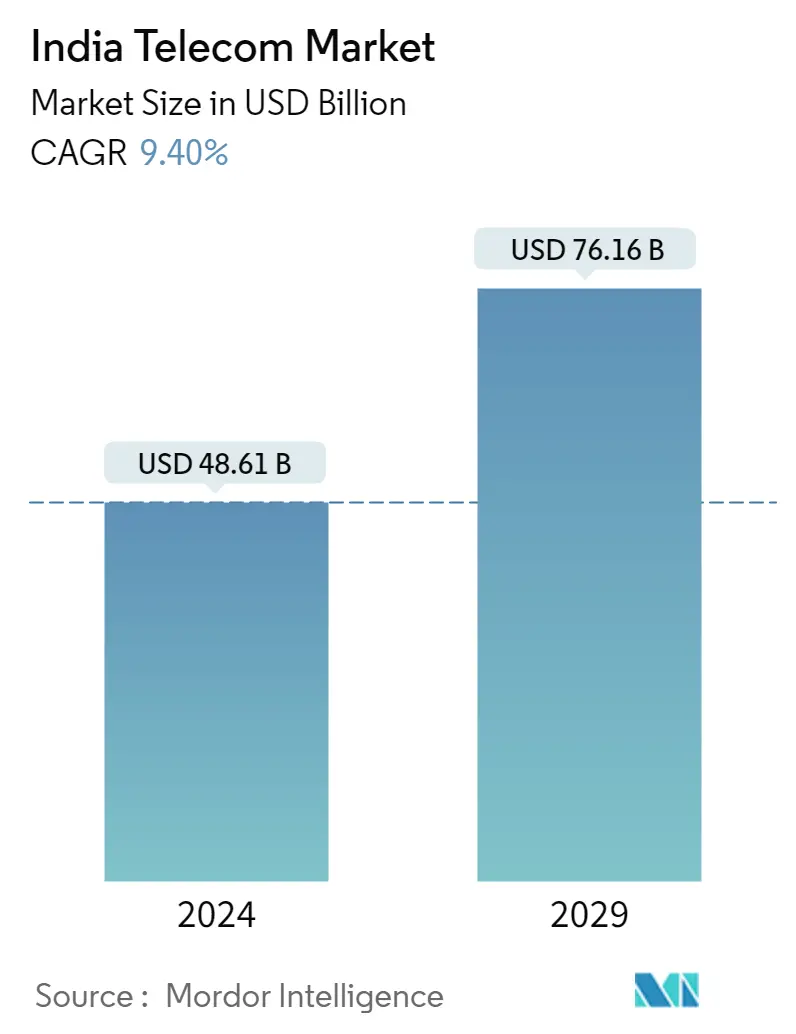
| Study Period | 2019 - 2029 |
| Base Year For Estimation | 2023 |
| Market Size (2024) | USD 48.61 Billion |
| Market Size (2029) | USD 76.16 Billion |
| CAGR (2024 - 2029) | 9.40 % |
| Market Concentration | High |
Major Players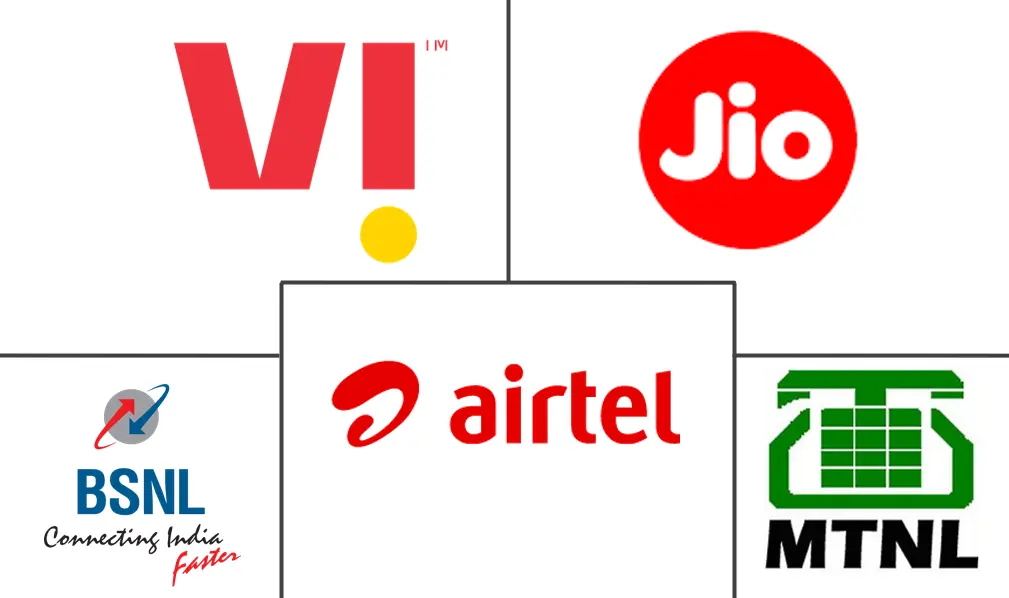
*Disclaimer: Major Players sorted in no particular order |
India Telecom Market Analysis
The India Telecom Market size is estimated at USD 48.61 billion in 2024, and is expected to reach USD 76.16 billion by 2029, growing at a CAGR of 9.40% during the forecast period (2024-2029).
- According to the IBEF, India has the world's second-largest telecom market. The total subscriber base, wireless subscriptions, and wired internet subscriptions have increased steadily. As of April 2022, teledensity stood at 84.88%, total broadband subscriptions increased to 788.77 million, and the overall subscriber base stood at 1.16 billion.
- In the first quarter of FY22, total wireless data usage in India increased by 16.54% quarterly to 32,397 PB. In the third quarter of FY21, 3G and 4G data usage contributed 1.78% and 97.74%, respectively, to total wireless data usage. In the same quarter, the share of 2G data use was 0.48%.
- The Department of Telecommunications (DoT) in India released the draught Telecom Bill 2022, which intends to alter the relationship between the government and the telecom industry. The main idea is to combine three acts (the Indian Telegraph Act 1885, the Indian Wireless Telegraphy Act 1933, and the Telegraph Wires (Unlawful Protection) Act 1950) into one.
- The first draught was recently used for public/stakeholder feedback. The law focuses primarily on the ease of doing business, providing sufficient infrastructure, making better use of the "valuable" spectrum, and establishing norms and procedures for litigation. Some key amendments are OTT players coming under a telecom infrastructure push, licensing regime, limiting, and (Telecom Regulatory Authority of India) TRAI.
- The telecom sector in India is expanding due to increasing end-user applications and growth in markets like IoT, cloud, data centers, and 5G. The country is also witnessing an increase in internet consumption. Market players are developing new internet plans to fulfill the growing demand for internet services and grab a more significant portion of the market.
- According to the announcement given by the telecom minister of India at TV9's Global Summit, 5G will be available in 20-25 towns and cities by the end of 2022, most likely by August or September.
- Every industry was affected by the COVID-19 outbreak. The telecom industry was significantly impacted, as it is essential for medical, government, and private-sector commercial activities to operate seamlessly. For instance, reliable, high-speed internet access is critical in ensuring that hospitals and medical institutions access worldwide information networks and resources needed to combat the virus. Broadband access is also vital for educational institutions and enterprises to continue providing essential services.
- The coronavirus's unexpected disruption of typical business operations prompted enterprises to operate remotely. This transition increased the demand for stronger network connectivity and internet availability, particularly in isolated or rural locations. Thus, the telecom (wireless and wireline) industry is attempting to provide better internet infrastructure to its clients. Even after the pandemic, the market is gaining traction across the country.
India Telecom Market Trends
This section covers the major market trends shaping the India Telecom Market according to our research experts:
Increasing Penetration of 4G and Upgradation of 5G
- Affordable rates, expanding 3G and 4G coverage, the advent of 5G shifting customer consumption patterns, the government's initiatives to strengthen India's domestic telecom manufacturing capacity, and a favorable regulatory environment contributed to the industry's exponential expansion in recent years.
- In October 2022, Bharti Airtel ("Airtel"), India's significant provider of communications solutions, announced the introduction of Airtel 5G+ in many major cities across the country. Customers in Delhi, Mumbai, Chennai, Bengaluru, Hyderabad, Siliguri, Nagpur, and Varanasi can enjoy cutting-edge Airtel 5G Plus services in stages as the firm builds its network and completes the rollout.
- The Department of Telecommunications was allocated INR 84,587 crores (USD 11.11 billion) in the Union Budget 2022-23, of which INR 30,436 crores (USD 3.99 billion) was revenue expenditure (36% of total expenditure) and INR 54,150 crore (USD 7.11 billion) was capital expenditure (64.01% of total expenditure).
- The government approved the sale of IMT/5G spectrum to deploy 5G services throughout the country to accelerate digital connectivity. This auction was completed by July 2022, grossing USD 18.77 billion.
- According to the IBEF, increased mobile phone penetration and lower data costs would bring 500 million new internet users across the country over the next five years, offering new business opportunities.
- In March 2021, Vodafone Idea Ltd (VIL) claimed that the purchased spectrum in five circles would assist boost 4G coverage and capacity, allowing it to provide users with an "improved digital experience."
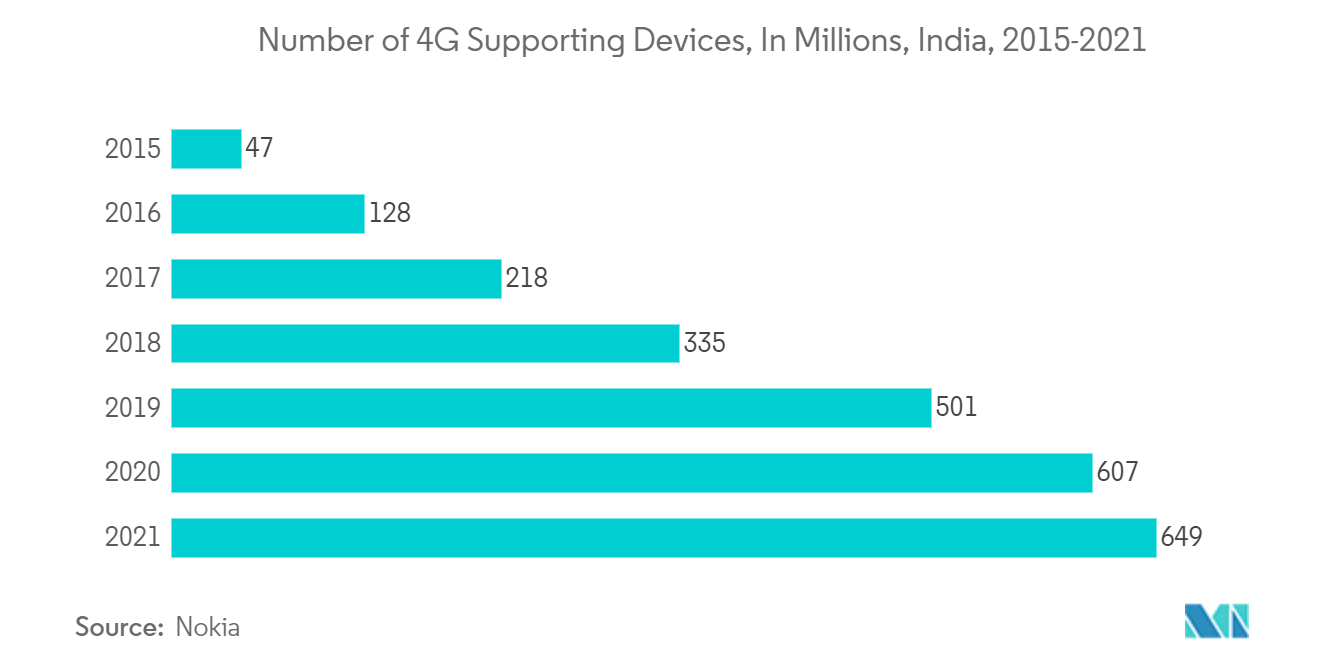
Growth of Data and Messaging Services
- In India, the demand for data and messaging services has been rising with an increase in telecom tower services across the country. For instance, The Indian telecom tower sector grew by 65% in the last seven years. Mobile towers increased from 4 lakhs in 2014 to 6.6 lakhs in 2021. Moreover, the number of mobile base transceiver stations climbed by 187%, from 8 lakhs in 2014 to 23 lakhs in 2021.
- Smartphones are a major source of data consumption and messaging services in India. According to the GSMA, India is on the path of becoming a significant smartphone market by 2025, with approximately 1 billion installed devices. It is predicted to have 920 million unique mobile customers by 2025, including 88 million 5G connections. 5G technology is expected to add USD 450 billion to the Indian economy between 2023 and 2040.
- The government focuses on increasing broadband network services, which will increase the use of Data. For instance, in July 2021, Bharat Broadband Network Limited (BBNL), on behalf of the Department of Telecommunications, issued a global procurement for the establishment of BharatNet in nine distinct packages covering 16 states during a 30-year concession period. The government would pay a maximum grant of INR 19,041 crores (USD 2.56 billion) as viability gap finance for this project.
- The Department of Telecommunications (DoT) formed a sixth-generation (6G) innovation group to drive the development of 6G technologies.
- Among the primary factors that lead to the segment's rise are the use of more than one device per user, high rates of replacement, and people transitioning from traditional phones to smartphones as prices drop.
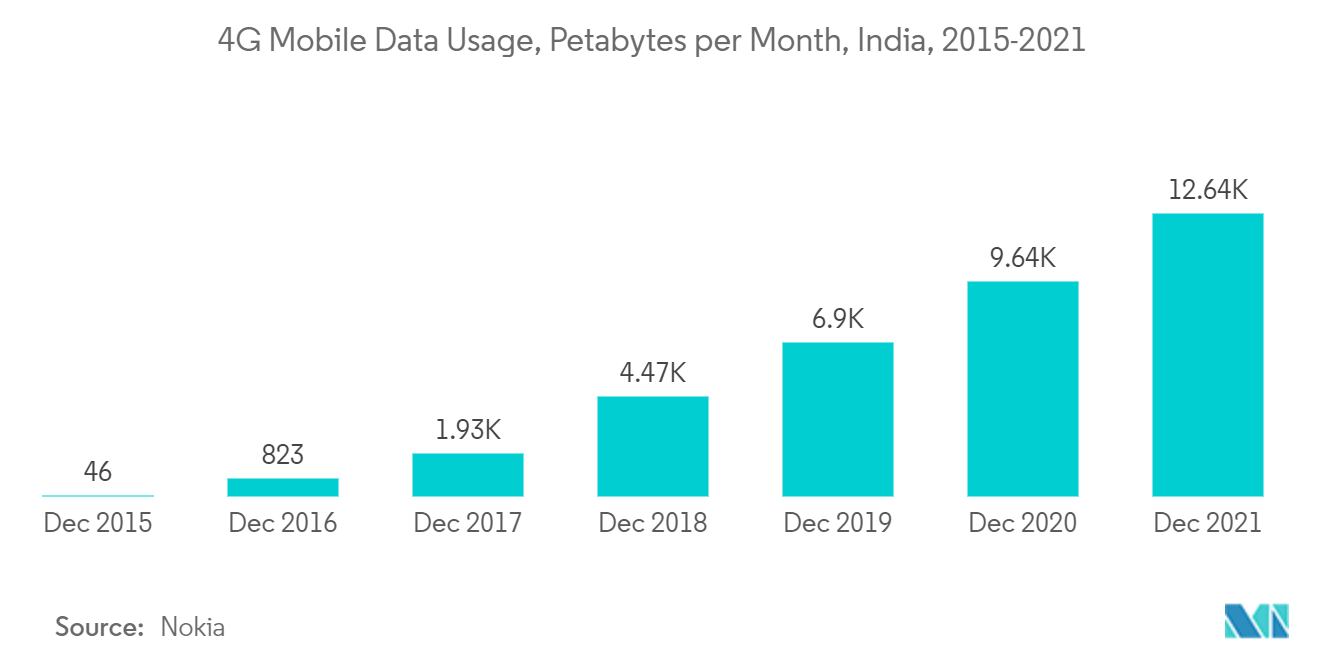
India Telecom Industry Overview
The Indian telecom market is consolidated with key players, such as Reliance Jio Infocomm, Bharti Airtel, Vodafone Idea Limited, Vodafone Idea Limited, and Mahanagar Telephone Nigam Ltd. ( MTNL) occupying the most market shares. These players focus on deploying the 5G network and increasing network capacity across the country to remain competitive in the market.
- October 2022 - Jio, following the successful announcement of its True-5G services in the India Mobile Congress 2022, launched the Beta trial of its True-5G services for Jio users in four cities - Delhi, Mumbai, Kolkata, and Varanasi - on the auspicious festival of Dussehra.
- October 2022 - Bharti Airtel ("Airtel"), India's significant provider of telecommunications services, announced the launch of the "Always On" IoT connectivity solution in India. Airtel's "Always On" solution includes a dual profile M2M eSim that allows an IOT device to stay connected to a mobile network from several Mobile Network Operators (MNOs) in the eSIM.
India Telecom Market Leaders
-
Reliance Jio Infocomm
-
Bharti Airtel
-
Vodafone Idea Limited
-
Bharat Sanchar Nigam Limited (BSNL)
-
Mahanagar Telephone Nigam Ltd. (MTNL)
*Disclaimer: Major Players sorted in no particular order
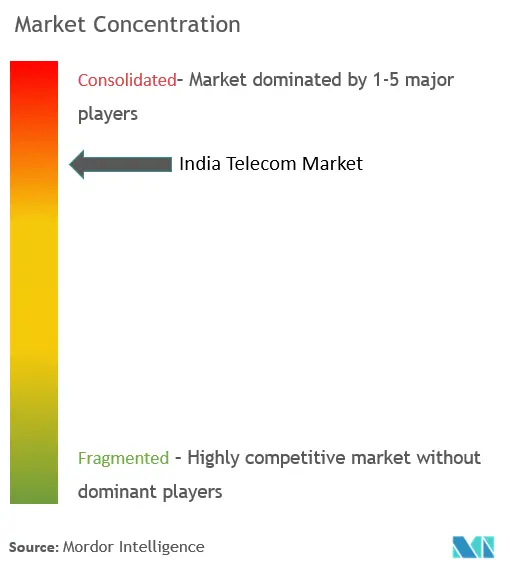
India Telecom Market News
- October 2022 - Vi (Vodafone Idea Limited) expanded network capacity in Andhra Pradesh and Telangana to ensure superior giganet 4G speed. It increased the deployment of the 1,800 MHz spectrum band to provide higher download and upload speeds. It also launched a campaign to emphasize Andhra Pradesh and Telangana's stronger and superior network.
- February 2022 - Jio Platforms Limited ("JPL"), India's significant digital service provider, and SES, a prominent global satellite-based content connectivity solutions provider, announced the formation of Jio Space Technology Limited, a joint venture to deliver next-generation scalable and affordable broadband services in India through satellite technology. JPL and SES will each own 51% and 49% of the joint company, respectively.
India Telecom Market Report - Table of Contents
1. INTRODUCTION
- 1.1 Study Assumptions and Market Definition
- 1.2 Scope of the Study
2. RESEARCH METHODOLOGY
3. EXECUTIVE SUMMARY
4. MARKET INSIGHTS
- 4.1 Market Overview
- 4.2 Industry Ecosystem Analysis
-
4.3 Industry Attractiveness-Porter's Five Force Analysis
- 4.3.1 Bargaining Power of Suppliers
- 4.3.2 Bargaining Power of Consumers
- 4.3.3 Threat of New Entrants
- 4.3.4 Threat of Substitute Products
- 4.3.5 Intensity of Competitive Rivalry
- 4.4 Impact of COVID-19 on the Industry Ecosystem
- 4.5 Regulatory Landscape in India
5. MARKET DYNAMICS
-
5.1 Market Drivers
- 5.1.1 Increasing Penetration of 4G and Upgradation of 5G
- 5.1.2 Foreign Direct Investment (FDI)
-
5.2 Market Restrain
- 5.2.1 Lack of Fixed Line Penetration
-
5.3 Analysis of the Market based on Connectivity (Coverage to include In-depth Trend Analysis)
- 5.3.1 Fixed Network
- 5.3.1.1 Broadband (Cable modem, wireline-fiber, wireline DSL, fixed Wi-Fi ), Trends regarding ADSL/VDSL, FTTP/B, cable modem, FWA, and 5G FWA )
- 5.3.1.2 Narrowband
- 5.3.2 Mobile Network
- 5.3.2.1 Smartphone and Mobile Penetration
- 5.3.2.2 Mobile Broadband
- 5.3.2.3 2G, 3G, 4G and 5G Connections
- 5.3.2.4 Smart Home IoT and M2M Connections
- 5.4 Analysis of Telecom Towers (Coverage to include in-depth trend analysis of various types of towers, like, lattice, guyed, monopole, and stealth towers)
6. MARKET SEGMENTATION
-
6.1 Segmentation by Services (Coverage to include Average Revenue Per User for the overall Services segment, Market size and Estimates for each segment for the period of 2020-2027 and in-depth Trend Analysis)
- 6.1.1 Voice Services
- 6.1.1.1 Wired
- 6.1.1.2 Wireless
- 6.1.2 Data and Messaging Services (Coverage to include Internet & Handset Data packages, Package Discounts)
- 6.1.3 OTT and Pay-tv Services
7. COMPETITIVE LANDSCAPE
-
7.1 Company Profiles
- 7.1.1 Reliance Jio Infocomm
- 7.1.2 Bharti Airtel
- 7.1.3 Vodafone Idea Limited
- 7.1.4 Bharat Sanchar Nigam Limited (BSNL)
- 7.1.5 Mahanagar Telephone Nigam Ltd ( MTNL)
- *List Not Exhaustive
8. INVESTMENT ANALYSIS
9. MARKET OPPORTUNITIES AND FUTURE TRENDS
** Subject To AvailablityIndia Telecom Industry Segmentation
The telecom industry comprises the sales of telecom goods and services by companies (organizations, single proprietorships, and partnerships) that supply communication hardware equipment for the transmission of voice, data, text, and video. The telecoms market also includes the sales of items by manufacturers like GPS equipment, cellular phones, and switching equipment.
The study provides an in-depth analysis of the telecommunication industry in India. The Indian telecom market is segmented by services, which is further classified into voice services (wired, wireless), data and messaging services, and OTT and pay-TV.
| Segmentation by Services (Coverage to include Average Revenue Per User for the overall Services segment, Market size and Estimates for each segment for the period of 2020-2027 and in-depth Trend Analysis) | Voice Services | Wired |
| Wireless | ||
| Segmentation by Services (Coverage to include Average Revenue Per User for the overall Services segment, Market size and Estimates for each segment for the period of 2020-2027 and in-depth Trend Analysis) | Data and Messaging Services (Coverage to include Internet & Handset Data packages, Package Discounts) | |
| OTT and Pay-tv Services |
India Telecom Market Research FAQs
How big is the India Telecom Market?
The India Telecom Market size is expected to reach USD 48.61 billion in 2024 and grow at a CAGR of 9.40% to reach USD 76.16 billion by 2029.
What is the current India Telecom Market size?
In 2024, the India Telecom Market size is expected to reach USD 48.61 billion.
Who are the key players in India Telecom Market?
Reliance Jio Infocomm, Bharti Airtel, Vodafone Idea Limited, Bharat Sanchar Nigam Limited (BSNL) and Mahanagar Telephone Nigam Ltd. (MTNL) are the major companies operating in the India Telecom Market.
What years does this India Telecom Market cover, and what was the market size in 2023?
In 2023, the India Telecom Market size was estimated at USD 44.43 billion. The report covers the India Telecom Market historical market size for years: 2019, 2020, 2021, 2022 and 2023. The report also forecasts the India Telecom Market size for years: 2024, 2025, 2026, 2027, 2028 and 2029.
What are the key factors driving the India Telecom Industry growth?
Major factors driving the growth of India Telecom Industry include a) Surge in demand for high-speed internet b) Government initiatives for digitalization c) Expansion of 4G and 5G networks across the country
What challenges does the India Telecom Market face?
Major challenges faced by the Telecom Industry in India are a) Regulatory hurdles b) High spectrum fees c) Need for significant investment in infrastructure to support the growing demand
Telecommunication in India Industry Report
The telecom industry in India, the world's second-largest telecommunications market, is experiencing significant market growth driven by increased smartphone usage and reduced data costs. This expansion is expected to bring in many new internet users, supported by favorable government policies and liberalized Foreign Direct Investment norms. The telecommunication industry in India is a crucial employment generator, thriving across wireless, wireline, and internet services segments, with wireless services leading the subscriber count. Both urban and rural markets are being catered to with specialized services amidst a competitive landscape marked by strategic alliances and technological advancements such as 4G and the anticipated 5G upgrades.
The government's National Broadband Mission aims to enhance broadband speeds and connectivity, reinforcing the sector's commitment to improving digital infrastructure. This mission aligns with the industry's outlook and market predictions, promising a robust future for India's telecom sector. Comprehensive industry reports and market reports provide detailed insights into the market size, industry analysis, and market segmentation, offering valuable information on market value and market trends.
Industry research highlights the importance of industry trends and industry statistics in understanding the sector's dynamics. Market data and market forecast are essential for anticipating future developments, while industry information and market overview provide a clear picture of current conditions. The telecom market's competitive nature is evident through the presence of market leaders and their strategic moves, contributing to the overall market review.
For a detailed industry profile, Mordor Intelligence™ Industry Reports offer an in-depth analysis, including market share, industry growth, and growth rate forecasts. These reports are available as a report pdf download, providing easy access to critical information for stakeholders. The market's structure and segmentation reveal the diverse range of services offered, catering to different consumer needs and preferences.
In summary, the telecom industry in India is on a dynamic growth path, supported by technological advancements, strategic alliances, and government initiatives. The industry's size and value continue to expand, driven by increasing demand for wireless and data services. Comprehensive industry reports and market research are essential tools for understanding the sector's trajectory and making informed decisions.



